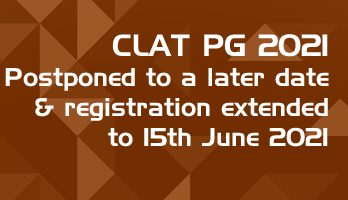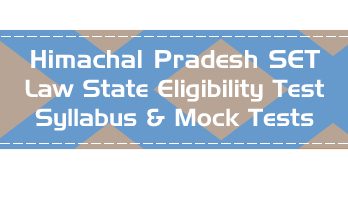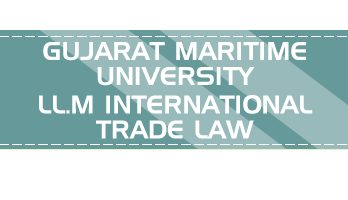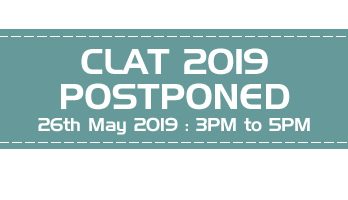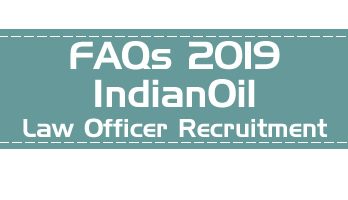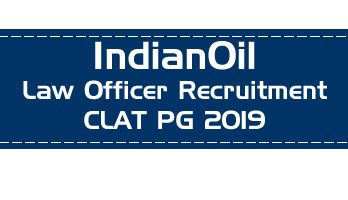Q : What is the best way to crack CLAT for LLM programme in India?
Ans :
This is a very long answer, copy-pasted from my answer(s) to similar questions . . .
First of all, the CLAT PG LLM entrance exam is a multiple choice objective type exam based on the entire LLB syllabus. But the crucial topics are Jurisprudence & Constitutional law – which together account for 2/3rd of the exam (66%).
Extensive theory is not the best way to prepare for multiple choice based exams. The ideal approach would be to solve as many MCQs as possible, covering the entire syllabus, with focus on the critical areas and solve all the previous papers you can find.
Solve at least two mock tests every day and after you have finished, re-attempt the ones from the previous day till you can blindly click on the right answer without thinking too much.
After all, almost 85% of the questions are repeats / variants from previous years or derived from ‘important questions’ from other similar exams.
The question poster then asked . . . Would it be possible to crack clat PG by studying only for a month?
Yes. Absolutely possible. If the paper had ‘subjective’ part, I would have had my reservations. But the advantage the CLAT LLM paper is :
(1) It is completely an objective paper
(2) There are no ‘analytical’ / ‘quants’ / ‘reasoning’ based questions
(3) A bulk of the questions emphasize more on memory & recognition skills (e.g. Which article says this . . . Which case is for what . . . What Salmond / Austin / Hart or Holmes said etc.)
(4) A significant number of questions are repeated / variations / adapted from previous exams or from other similar exams.)
So, the answer to your question is ‘Yes’.
What’s the approach?
Complete 2 (or preferably 3 or more) mock tests every day. Review the results carefully and make a note of the questions you got wrong and memorize the correct answers.
Repeat the process every day till you circle back to the first set of mock tests and just keep repeating the cycle.
In around 10 – 15 days, you will have become familiar with a bulk of the ‘important’ questions; and you will know the answer by instinct and your scores will start going up.
Most of the LLM entrance questions don’t need any explanation or reasoning . For example, look at the first 6 questions from CLAT PG listed below.
Once you know & remember the correct answer, you can answer these questions & any variations thereof.
1. If any question arises whether a Bill is a Money Bill or not, the decision given by the shall be final:
(a) Finance Minister
(b) Speaker of the Lok Sabha
(c) Vice-President
(d) Prime Minister.
2. Part IX-B of the Constitution of India dealing with the ‘Co-operative Societies’ was inserted by:
(a) The Constitution (Ninety Fifth Amendment) Act, 2009
(b) The Constitution (Ninety Eighth Amendment) Act, 2012
(c) The Constitution (Ninety Third Amendment) Act, 2005
(d) The Constitution (Ninety Seventh Amendment) Act, 2011.
3. Article 280 of the Constitution of India deals with:
(a) Finance Commission
(b) Election Commission of India
(c) Union Public Service Commission
(d) Comptroller and Auditor-General.
4. Which provision of the Constitution of India deals with the representation of the Anglo-Indian Community in the House of the People?
(a) Article 331
(b) Article 332
(c) Article 333
(d) Article 330.
5. In State of Maharashtra v. Dr. Praful B. Desai, 2003 SC the Supreme Court of India held:
(a) Right to speedy trial is part and parcel of Right to life under Article 21 of the Constitution
(b) It is obligatory on the employer to compute the family pension and offer the same to the widow even without making a claim on her part
(c) Where lawyers boycott or are on strike it is the duty of the court to carry on with court proceedings
(d) Recording of evidence through Vedio- conferencing so long the accused and/or his pleader are present while recording is as per “procedure established by law” and hence valid.
6. In which of the following judgment, the scope of writ of Habeas Corpus was widened?
(a) D.K. Basu v. State of West Bengal, (1998 SC)
(b) Sheela Barse v. Union of India, (1983 SC)
(c) Sunil Batra v. Delhi Administration, (1978 SC)
(d) M.C. Mehta v. Union of India, (1987 SC)
So, if the objective is to score high marks in the CLAT PG LLM, yes, one month of dedicated practice is good enough.
If you are appearing in the CLAT PG , we have published the
Q : How can one prepare for CLAT (LLM)? Is there any coaching institute which provides guidance for LLM Entrance Test?
Ans :
Edit (22/11/ ) : For CLAT PG 2019, there is a tentative announcement that a subjective part will be included. That will not change the gist of the answer below. It still holds true for the objective part – which should be for not less than 100 marks.
For the subjective part, we’ll have to wait for the official CLAT 2019 announcement to understand the scope & pattern of the subjective part.
This is a very long answer, copy-pasted from my answer(s) to similar questions . . .
First of all, the CLAT PG LLM entrance exam is a multiple choice objective type exam based on the entire LLB syllabus. But the crucial topics are Jurisprudence & Constitutional law – which together account for 2/3rd of the exam (66%).
Extensive theory is not the best way to prepare for multiple choice based exams. The ideal approach would be to solve as many MCQs as possible, covering the entire syllabus, with focus on the critical areas and solve all the previous papers you can find.
Solve at least two mock tests every day and after you have finished, re-attempt the ones from the previous day till you can blindly click on the right answer without thinking too much.
After all, almost 85% of the questions are repeats / variants from previous years or derived from ‘important questions’ from other similar exams.
The question poster then asked . . . Would it be possible to crack clat PG by studying only for a month?
Yes. Absolutely possible. If the paper had ‘subjective’ part, I would have had my reservations. But the advantages the CLAT LLM paper are :
(1) It is completely an objective paper
(Note: From 2019, there might be a subjective part. This will be clarified once the official CLAT 2019 announcement is published.)
(2) There are no ‘analytical’ / ‘quants’ / ‘reasoning’ based questions
(3) A bulk of the questions emphasize more on memory & recognition skills (e.g. Which article says this . . . Which case is for what . . . What Salmond / Austin / Hart or Holmes said etc.)
(4) A significant number of questions are repeated / variations / adapted from previous exams or from other similar exams.)
So, the answer to your question is ‘Yes’.
What’s the approach?
Complete 2 (or preferably 3 or more) mock tests every day. Review the results carefully and make a note of the questions you got wrong and memorize the correct answers.
Repeat the process every day till you circle back to the first set of mock tests and just keep repeating the cycle.
In around 10 – 15 days, you will have become familiar with a bulk of the ‘important’ questions; and you will know the answer by instinct and your scores will start going up.
Most of the LLM entrance questions don’t need any explanation or reasoning . For example, look at the first 6 questions from CLAT PG listed below.
Once you know & remember the correct answer, you can answer these questions & any variations thereof.
1. If any question arises whether a Bill is a Money Bill or not, the decision given by the shall be final:
(a) Finance Minister
(b) Speaker of the Lok Sabha
(c) Vice-President
(d) Prime Minister.
2. Part IX-B of the Constitution of India dealing with the ‘Co-operative Societies’ was inserted by:
(a) The Constitution (Ninety Fifth Amendment) Act, 2009
(b) The Constitution (Ninety Eighth Amendment) Act, 2012
(c) The Constitution (Ninety Third Amendment) Act, 2005
(d) The Constitution (Ninety Seventh Amendment) Act, 2011.
3. Article 280 of the Constitution of India deals with:
(a) Finance Commission
(b) Election Commission of India
(c) Union Public Service Commission
(d) Comptroller and Auditor-General.
4. Which provision of the Constitution of India deals with the representation of the Anglo-Indian Community in the House of the People?
(a) Article 331
(b) Article 332
(c) Article 333
(d) Article 330.
5. In State of Maharashtra v. Dr. Praful B. Desai, 2003 SC the Supreme Court of India held:
(a) Right to speedy trial is part and parcel of Right to life under Article 21 of the Constitution
(b) It is obligatory on the employer to compute the family pension and offer the same to the widow even without making a claim on her part
(c) Where lawyers boycott or are on strike it is the duty of the court to carry on with court proceedings
(d) Recording of evidence through Vedio- conferencing so long the accused and/or his pleader are present while recording is as per “procedure established by law” and hence valid.
6. In which of the following judgment, the scope of writ of Habeas Corpus was widened?
(a) D.K. Basu v. State of West Bengal, (1998 SC)
(b) Sheela Barse v. Union of India, (1983 SC)
(c) Sunil Batra v. Delhi Administration, (1978 SC)
(d) M.C. Mehta v. Union of India, (1987 SC)
So, if the objective is to score high marks in the CLAT PG LLM, yes, one month of dedicated practice is good enough.
If you are appearing in the CLAT PG , we have published the
Q : Is the Clat is easy for LLM aspirant than LLB candidate?
Ans :
It’s all relative . . . and candidates should not get worried about it . . .
CLAT & CLAT PG are for different courses, so there is no direct competition between the candidates applying for these exams.
CLAT is a generic exam – meant to be taken by candidates from all streams; so it will be generic in nature.
CLAT PG is restricted to Law graduates; so the exam can be more ‘subject specific’ i.e. based on the LLB syllabus.
In any case, if a exam is ‘tough’, it will be equally tough for all the candidates, if it is ‘easy’, it will be easy for all the candidates . . . the overall ‘Ranking’ will not change; only the marks will change – which will change ‘+’vely or ‘-’vely for all candidates.
Q : What was the AILET cutoff for LLM?
Ans :
AILET LLM . . .
For 2017, the maximum score was 119. (out of 100 marks – MCQs + 50 marks – Essay)
49 students were called for the counselling for the General Category seats.
There were several students who had scored the same marks in the AILET (See the marks & the number of students indicated below)
For students with the same marks, the final ranking was decided by factoring in the student’s LLB marks.
So, you can say that the ‘Cut-off’ for AILET PG for General category was 75 marks out of 150.
Marks – Number of students, if more than 1
119
114
96
93
92
89
88 – 3
87
84 – 3
83 – 5
82 – 2
81
80
79 – 3
78 – 6
77 – 7
76 – 4
75 – 6
Q : How can I get an admission into national law universities for an LLM?
Ans :
Through the CLAT PG, AILET PG & HPNLET PG . . .
CLAT is the common entrance exam for most of the National Law Schools / National Law Universities across India.
Basic eligibility is 55% in LLB (50% for reserved categories.)
NLU Delhi and HPNLU Shimla do not participate in the CLAT as they have their own separate exams, eligibility is similar to CLAT.
Register here for CLAT PG :
Q : What is the eligibility for joining LLM?
Ans :
There are three ways to taking up an LLM course . . .
[1] Without any entrance exam – There are many tier-3 and some tier-2 Law Colleges across India, where admission is done on a first-come-first-admitted basis.
No entrance exam. Just meet the minimum criteria in terms of your previous academics and pay the fees. The basic eligibility will be 50% in your LLB. (45% for reserved categories)
Some even have a Distance education LLM programs.
[2] With entrance exam – there are tier 2 & tier 1 colleges that have their own entrance exam and in some states there is a common entrance exam for Law Courses across many participating colleges – tier 2 & 3.
For example, the Andhra Pradesh – AP PGLCET, Telangana – TS PGLCET, Kerala CEE , DU LLM entrance exam etc.
Bulk of the seats are filled through the exams, but there will usually be a ‘Management quota’ of seats with higher fees in private colleges that participate in these common entrance process.
Basic eligibility here is usually LLB with at least 50% or 55% (depending on the institute rules), with some relaxation for reserved categories.
[3] Through CLAT – CLAT is the common entrance exam for the National Law Schools / National Law Universities across India.
Basic eligibility is 55% in LLB (50% for reserved categories.)
Note : NLU Delhi and HPNLU Shimla do not participate in the CLAT as they have their own separate exam, eligibility is similar to CLAT.
Q : How much marks and rank does one need in CLAT PG for getting in PSU?
Ans :
You just need to prepare well, give it your best shot and hope for a high AIR.
(Copy pasting from my answer to a similar question.)
Looking at last year’s results 5475 candidates appeared for the exam and the AIR 1 was at 125 marks and the AIR 5475 was at minus 4.75 marks. (CLAT has negative marking.)
Now, there are 632 PG seats through the CLAT PG and there will be around 50 PSU posts recruited through the CLAT PG. (Currently I am aware of ONGC- 15 posts, PGCIL – 6 posts, BHEL – 12 posts and a few more should get added in the next few weeks taking the number to around 50.)
However, PSU posts are quite attractive to a number of students; so the higher the rank the better. Though I don’t have any numbers / data – I would expect the PSU posts to get closed within AIR 300 max. (Apart from the CLAT ranking, there will also be GD, Interview etc. for PSU posts)
Last year’s ONGC cut-offs were :
Category Cut-off Score
UR 109.25
OBC 98.75
SC 90.25
ST 91.50
PWD (VH) 81.25
Bottom-line : Aim at scoring an AIR of within 300 or higher.
If you are appearing in the CLAT PG , we have published the
Q : Is it easy to crack CLAT PG to get a job in PSU?
Ans :
You just need to prepare well, give it your best shot and aim for a high AIR.
Looking at lat year’s results 5475 candidates appeared for the exam and the AIR 1 was at 125 marks and the AIR 5475 was at minus 4.75 marks. (CLAT has negative marking.)
Now, there are 632 PG seats through the CLAT PG and there will be around 50 PSU posts recruited through the CLAT PG. (Currently I am aware of ONGC- 15 posts, PGCIL – 6 posts, BHEL – 12 posts and a few more should get added in the next few weeks taking the number to around 50.)
So, a ranking of around 700 or higher should get you a PG seat somewhere or a PSU post.
However, PSU posts are quite attractive to a number of students; so the higher the rank the better. Though I don’t have any numbers / data – I would expect the PSU posts to get closed within AIR 250. (Apart from the CLAT ranking, there will also be GD, Interview etc. for PSU posts)
Last year’s ONGC cut-offs were :
Category Cut-off Score
UR 109.25
OBC 98.75
SC 90.25
ST 91.50
PWD (VH) 81.25
Bottom-line : Aim at scoring an AIR of within 300 or higher.
We have published an update (as on 19th Apr ) on the PSUs recruiting through the CLAT PG .
You can read the article here :
Q : Which are the best applications for preparation of PG CLAT examination?
Ans :
If you are appearing in the CLAT PG , we have published the
Q : How do you score well in the CLAT PG entrance exam? What should one focus more on?
Ans :
This is a very long answer, copy-pasted from my answer(s) to similar questions . . .
First of all, the CLAT PG LLM entrance exam is a multiple choice objective type exam based on the entire LLB syllabus. But the crucial topics are Jurisprudence & Constitutional law – which together account for 2/3rd of the exam (66%).
Extensive theory is not the best way to prepare for multiple choice based exams. The ideal approach would be to solve as many MCQs as possible, covering the entire syllabus, with focus on the critical areas and solve all the previous papers you can find.
Solve at least two mock tests every day and after you have finished, re-attempt the ones from the previous day till you can blindly click on the right answer without thinking too much.
After all, almost 85% of the questions are repeats / variants from previous years or derived from ‘important questions’ from other similar exams.
The question poster then asked . . . Would it be possible to crack clat PG by studying only for a month?
Yes. Absolutely possible. If the paper had ‘subjective’ part, I would have had my reservations. But the advantage the CLAT LLM paper is :
(1) It is completely an objective paper
(2) There are no ‘analytical’ / ‘quants’ / ‘reasoning’ based questions
(3) A bulk of the questions emphasize more on memory & recognition skills (e.g. Which article says this . . . Which case is for what . . . What Salmond / Austin / Hart or Holmes said etc.)
(4) A significant number of questions are repeated / variations / adapted from previous exams or from other similar exams.)
So, the answer to your question is ‘Yes’.
What’s the approach?
Complete 2 (or preferably 3 or more) mock tests every day. Review the results carefully and make a note of the questions you got wrong and memorize the correct answers.
Repeat the process every day till you circle back to the first set of mock tests and just keep repeating the cycle.
In around 10 – 15 days, you will have become familiar with a bulk of the ‘important’ questions; and you will know the answer by instinct and your scores will start going up.
Most of the LLM entrance questions don’t need any explanation or reasoning . For example, look at the first 6 questions from CLAT PG listed below.
Once you know & remember the correct answer, you can answer these questions & any variations thereof.
1. If any question arises whether a Bill is a Money Bill or not, the decision given by the shall be final:
(a) Finance Minister
(b) Speaker of the Lok Sabha
(c) Vice-President
(d) Prime Minister.
2. Part IX-B of the Constitution of India dealing with the ‘Co-operative Societies’ was inserted by:
(a) The Constitution (Ninety Fifth Amendment) Act, 2009
(b) The Constitution (Ninety Eighth Amendment) Act, 2012
(c) The Constitution (Ninety Third Amendment) Act, 2005
(d) The Constitution (Ninety Seventh Amendment) Act, 2011.
3. Article 280 of the Constitution of India deals with:
(a) Finance Commission
(b) Election Commission of India
(c) Union Public Service Commission
(d) Comptroller and Auditor-General.
4. Which provision of the Constitution of India deals with the representation of the Anglo-Indian Community in the House of the People?
(a) Article 331
(b) Article 332
(c) Article 333
(d) Article 330.
5. In State of Maharashtra v. Dr. Praful B. Desai, 2003 SC the Supreme Court of India held:
(a) Right to speedy trial is part and parcel of Right to life under Article 21 of the Constitution
(b) It is obligatory on the employer to compute the family pension and offer the same to the widow even without making a claim on her part
(c) Where lawyers boycott or are on strike it is the duty of the court to carry on with court proceedings
(d) Recording of evidence through Vedio- conferencing so long the accused and/or his pleader are present while recording is as per “procedure established by law” and hence valid.
6. In which of the following judgment, the scope of writ of Habeas Corpus was widened?
(a) D.K. Basu v. State of West Bengal, (1998 SC)
(b) Sheela Barse v. Union of India, (1983 SC)
(c) Sunil Batra v. Delhi Administration, (1978 SC)
(d) M.C. Mehta v. Union of India, (1987 SC)
So, if the objective is to score high marks in the CLAT PG LLM, yes, one month of dedicated practice is good enough.
If you are appearing in the CLAT PG , we have published the
Q : Can someone come up with an awesome strategy to crack CLAT PG?
Ans :
This is a very long answer, copy-pasted from my answer(s) to similar questions . . .
First of all, the CLAT PG LLM entrance exam is a multiple choice objective type exam based on the entire LLB syllabus. But the crucial topics are Jurisprudence & Constitutional law – which together account for 2/3rd of the exam (66%).
Extensive theory is not the best way to prepare for multiple choice based exams. The ideal approach would be to solve as many MCQs as possible, covering the entire syllabus, with focus on the critical areas and solve all the previous papers you can find.
Solve at least two mock tests every day and after you have finished, re-attempt the ones from the previous day till you can blindly click on the right answer without thinking too much.
After all, almost 85% of the questions are repeats / variants from previous years or derived from ‘important questions’ from other similar exams.
The question poster then asked . . . Would it be possible to crack clat PG by studying only for a month?
Yes. Absolutely possible. If the paper had ‘subjective’ part, I would have had my reservations. But the advantage the CLAT LLM paper is :
(1) It is completely an objective paper
(2) There are no ‘analytical’ / ‘quants’ / ‘reasoning’ based questions
(3) A bulk of the questions emphasize more on memory & recognition skills (e.g. Which article says this . . . Which case is for what . . . What Salmond / Austin / Hart or Holmes said etc.)
(4) A significant number of questions are repeated / variations / adapted from previous exams or from other similar exams.)
So, the answer to your question is ‘Yes’.
What’s the approach?
Complete 2 (or preferably 3 or more) mock tests every day. Review the results carefully and make a note of the questions you got wrong and memorize the correct answers.
Repeat the process every day till you circle back to the first set of mock tests and just keep repeating the cycle.
In around 10 – 15 days, you will have become familiar with a bulk of the ‘important’ questions; and you will know the answer by instinct and your scores will start going up.
Most of the LLM entrance questions don’t need any explanation or reasoning . For example, look at the first 6 questions from CLAT PG listed below.
Once you know & remember the correct answer, you can answer these questions & any variations thereof.
1. If any question arises whether a Bill is a Money Bill or not, the decision given by the shall be final:
(a) Finance Minister
(b) Speaker of the Lok Sabha
(c) Vice-President
(d) Prime Minister.
2. Part IX-B of the Constitution of India dealing with the ‘Co-operative Societies’ was inserted by:
(a) The Constitution (Ninety Fifth Amendment) Act, 2009
(b) The Constitution (Ninety Eighth Amendment) Act, 2012
(c) The Constitution (Ninety Third Amendment) Act, 2005
(d) The Constitution (Ninety Seventh Amendment) Act, 2011.
3. Article 280 of the Constitution of India deals with:
(a) Finance Commission
(b) Election Commission of India
(c) Union Public Service Commission
(d) Comptroller and Auditor-General.
4. Which provision of the Constitution of India deals with the representation of the Anglo-Indian Community in the House of the People?
(a) Article 331
(b) Article 332
(c) Article 333
(d) Article 330.
5. In State of Maharashtra v. Dr. Praful B. Desai, 2003 SC the Supreme Court of India held:
(a) Right to speedy trial is part and parcel of Right to life under Article 21 of the Constitution
(b) It is obligatory on the employer to compute the family pension and offer the same to the widow even without making a claim on her part
(c) Where lawyers boycott or are on strike it is the duty of the court to carry on with court proceedings
(d) Recording of evidence through Vedio- conferencing so long the accused and/or his pleader are present while recording is as per “procedure established by law” and hence valid.
6. In which of the following judgment, the scope of writ of Habeas Corpus was widened?
(a) D.K. Basu v. State of West Bengal, (1998 SC)
(b) Sheela Barse v. Union of India, (1983 SC)
(c) Sunil Batra v. Delhi Administration, (1978 SC)
(d) M.C. Mehta v. Union of India, (1987 SC)
So, if the objective is to score high marks in the CLAT PG LLM, yes, one month of dedicated practice is good enough.
If you are appearing in the CLAT PG , we have published the
Q : Where can I find the previous years’ CLAT PG question papers?
Ans :
Previous question papers . . .
At
Q : Can I get into NLSIU with CLAT PG score of 80?
Ans :
In . . .
21 candidates scored exactly 80 marks and got an AIR of 759 to 779. (If multiple candidates score the same marks, then age & random ranking by computer are used to break the tie.)
For , the total number of LLM seats via the CLAT PG in NLSIU is 50.
You also need to factor in any reserved seats from within the 50.
Realistically speaking, since NLSIU is a much sought after institute, the chances of candidates dropping out after getting a seat / opting for a different institute will be minimal.
But yes, some candidates will prefer an institute close to their home town and some even drop out completely to pursue other courses e.g. MBA / IAS / Judicial etc. – so let us take the drop out rate at 10%.
So, with 80 marks – I would say – highly improbable.
IMHO, a score of 107.5+ which should translate to a 60 or better ranking is a more realistic level to get into the NLSIU
BTW . . .
If you are appearing in the CLAT PG , we have published the
Q : What were the marks of topper of CLAT PG?
Ans :
The Top Ten AIR holders in CLAT PG 2017
All India Rank. Total score
- 125.00
- 121.50
- 120.25 ***
- 120.25 ***
- 119.25
- 119.00
- 118.75
- 116.75
- 116.50
- 116.25
*** 3 & 4 have the same marks, in which case, the tie is sorted using age as the primary criteria (higher the better) and if both candidates are of the same age, then random choice by computer is used to decide the ranking.
If you are appearing in the CLAT PG , we have published the
Q : How much marks do I need to score to get a rank in the first 400 in CLAT PG exam?
Ans :
There are several factors that go into calculating the AIR.
If we look at AIR list for the previous year, AIR 393 to 401 all have scored 91 marks.
So the answer to your question will be – Considering that the complexity of the paper and the quality of the candidates will more-or-less be similar between & , a candidate will have to score at least 91 marks to aim at a 400 & better AIR.
But how is it possible that there are 9 people who scored the same marks (91) and but got different ranks from 393 to 401 ?
The CLAT instructions say
“In case of equal marks, the break of tie shall be by procedure and order as under:
- Higher age;
- Computerized draw of lots.”
On a lighter note, I can say that, to score a better AIR, apart from marks, you need to have age (1) & luck (2) on your side 🙂
Q : Which is the number 1 ranked law college in India?
Ans :
Rankings are very subjective and should be taken with a pinch of salt . . .
Personally, I believe the top ten institutes in all of these rankings are great places to learn and more-or-less equal from an academics, quality of peers and facilities perspective.
But what gives some institutes an edge are variables such as placements, number of published papers by the faculty etc.
While rankings are useful; do try to see what are the underlying parameters used for the rankings and how the institutes score on those specific variables.
Rankings are also a self-fulling prophesy of sorts,; for example since placements are usually one of the significant variables in the ranking process;
> an institute that is located in or around major metros / employment hubs will get better placements (company recruiters find it easier to travel to the campus)
> which will help get better rankings
> which will attract more companies to campus next year
> which will help in getting getting better placements
> . . . better rankings . . . and the cycle continues.
That said, various rankings such as Outlook, India Today, HT Campus, The Week etc. rank NLSIU, Bangalore as No.1 and the rest of the top 15 have almost the same colleges, with their rankings shuffled.
[1]
Q : Between a 3 year LLB course or a 5 year BA LLB course, which one is better?
Ans :
Thanks for the A2A. I answered the same / similar question sometime earlier. Copy-pasting the answer from that question with a little modification . . .
Let us look at the question from a time point of view.
- BA degree is a 3 year program
- LLB degree is a 3 year program
So if you complete your BA first and then take take up LLB, you will have spent 6 years to obtain your BA + LLB.
An integrated dual-degree 5 year LLB program will give you a BCom / BBA / BA + LLB – so you save one year.
Let us look at the question from a career plan point of view.
If your aspiration is to ultimately pursue a law degree, it makes sense to enrol in a integrated BA LLB program.
But remember :
– It is a five year commitment, sometimes life happens, plans change etc.
– Then there is a risk of not getting any degree – Depending on the College / University rules, you may not get even a BA degree if you decide to opt-out midway.
If you are not sure of your long term career plans, you should complete your BA first and then decide on a MBA / LLB at a later date.
Let us look at the question from an employment prospects point of view
If you intend to pursue a BA + LLB, i.e. an integrated five year course, the National Law Schools (National Law Universities) score above regular Universities in terms of campus placements and corporate career opportunities.
The best law firms from across India come to recruit from the NLU campuses; whereas graduates from other Universities will not have the same advantage.
A 5 year LLB graduate from a regular University will be treated by recruiters as on par with a 3 year LLB graduate from same / similar Universities.
[* Some University Law Colleges do have campus placements, but they typically do not attract the Tier-1 law firms]
Bottom-line : The BA or BA + LLB decision really depends on your long term career aspirations and personal preference.
BA+LLB saves you one year, but it requires a five year commitment.
Completing a BA first will give you an opportunity to choose between MBA / LLB / taking up employment after graduation.
If BA+LLB is your decision, aim for the National Law Schools and the Top colleges in India to get the maximum ROI from your degree from an employment perspective.
If independent practice is your goal, it doesn’t matter where and how you complete your LLB. You PR management, contacts and business development skills will be the key to success.
Q : What is the total duration of an LLM programme at TERI SAS, and what is the eligibility criteria for it?
Ans :
You should check out the latest & updated information on the TERI SAS website . . .
The complete details about the programs, the admissions process etc. are in their –19 brochure.
See page 51 onward :
Q : Is a one-year LLM program valid for doing legal research?
Ans :
Yes.
A UGC recognized one year LLM is equivalent to the two year program. In fact, given that there is saving of one year, the one year program is becoming more popular, with more and more institutions offering it.
- Why don’t all institutes offer a one year program if it is equivalent to a two year program ?
- Why do the two year programs still exist?
Not all institutes can offer a one year program. UGC has set some criteria – such as : (From the UGC website)
(i) Every university desirous of starting one year LLM programme under these Guidelines shall establish a Centre for Post-Graduate Legal Studies (CPGLS) which will have a dedicated team of senior teachers competent to guide post-graduate scholars including Ph. D. students.
(ii) Post-Graduate education in law is to be offered only after fulfilling the minimum requirements in terms of faculty, infrastructure etc. prescribed under these Guidelines.
(iii) Admission to one-year LL.M. Degree shall be done through an All India Admission Test conducted every year by the Universities individually or by a group of universities collectively.
(iv) While reducing the duration to one year, universities must ensure that steps may be taken to make the course rigorous to maintain academic quality and standards. Towards this end, the programme is to be organized on a trimester basis ensuring at least twelve weeks of teaching/research/practical in each trimester.
The switch from the two year to one year program will involve syllabus changes, logistics changes etc. So it will take some time for all institutes to eventually move to a one year pattern.
The two year pattern will still remain in niche areas, since it allows for a higher degree of specialization and the institutes offering it will have a higher level of autonomy in terms of syllabus, admissions etc.
Q : How can I get previous question papers for LLM?
Ans :
Which LLM entrance are you referring to ?
If you prefer books, there are plenty of them available on Amazon. Most prep books will include previous year question papers.
Just ensure you buy the latest edition, which should have the most recent question papers.
If you prefer to practice online – on your Mobile / PC / Laptop / Tab . . .


